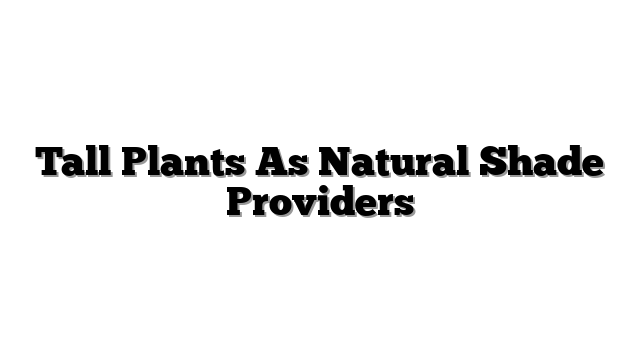Tall Plants As Natural Shade Providers
Hot summer sun? It beats down hard. Your home heats up fast. Energy bills climb high. Your yard feels too hot. Nobody wants to sit outside. There is a better way.
Tall plants offer a natural fix. They give cooling shade. They make your home cooler. They lower your energy costs. Plants make your yard lovely. You can use your outdoor space. Plants help the planet too. They clean the air we breathe. They give homes to birds. They soak up rain water.
This guide helps you choose. We will show you how to plant. We cover how to care for them. You will learn how to design. We explore many plant types. This includes tall plants as natural shade providers. We cover gardening for beginners. We discuss landscape design ideas.
The Power of Natural Shade: Why Tall Plants are Your Best Bet
Plants do more than look good. They offer many benefits. Shade is just one part.
More Than Just Shade: The Multifaceted Benefits
Tall plants give real comfort. They block harsh sun rays. This cools the air around them. They make your patio usable. Your deck feels nice and cool. Your yard becomes a haven. Plants add beauty. They bring green to your space.
Reducing Energy Bills: A Green Approach to Cooling
Plants cool your home naturally. They block sun from windows. They shade your roof. This means your air conditioner works less. You use less power. Your energy bills go down. Experts agree on this point. One study showed trees can cut cooling costs by 20-40%. This is a big saving.
Environmental Impact: Air Quality, Habitat, and Stormwater
Plants clean our air. They take in bad gases. They release fresh oxygen. They give homes for insects. Birds build nests in them. Plants help manage water. Their roots soak up rain. This stops water runoff. It helps our local rivers.
Enhancing Your Outdoor Living Space
Your yard becomes more useful. Shaded spots are great for relaxing. You can eat meals outside. Kids can play safely. Plants make your space feel private. They create a calm feeling. It feels like a retreat.
Comparing Natural vs. Artificial Shade Structures
Structures like roofs offer shade. Plants offer more. Plants cool the air itself. Structures just block sun. Plants clean air. Structures do not. Plants support nature. Structures do not. Plants grow more beauty. Structures stay the same. Plants cost less over time. Structures need repair.
We can map sun paths. Find the hottest spots. These are places needing shade.
Selecting the Right Tall Plants for Your Climate and Needs
Picking plants is key. You must choose wisely. Your plants will thrive.
Understanding Your Hardiness Zone and Microclimate
Plants need the right cold. Each plant handles cold differently. Your hardiness zone tells you this. Look up your zone number. Pick plants that match your zone. Your yard has small areas. Some are warmer, some colder. This is your microclimate. Consider these small differences.
Assessing Site Conditions: Sunlight, Soil, and Space
How much sun hits the spot? Watch it all day long. Note morning sun. See afternoon sun. Plants need certain light. Some need full sun. Others need some shade. Soil type matters a lot. Is it sandy? Is it clay? Does water drain well? Plants need good soil. How much space is there? Plants grow very big. Know the mature size. Check for power lines. Look for underground pipes.
Deciduous vs. Evergreen: Choosing for Seasonal Shade
Deciduous trees lose leaves. They give summer shade. They let winter sun through. Evergreen plants keep leaves. They give shade all year. Think about what you need. Summer shade only? Or shade all year?
Considering Mature Size, Shape, and Root Systems
Plants start small. They grow very large. Know the final size. Will it fit the space? What shape will it have? Some are wide. Some are tall and narrow. Roots spread out far. Some roots go deep. Some roots spread wide near the top. Plant far from buildings. Keep roots from pipes.
2025 Trend: Prioritizing Native Tall Plants for Shade
Native plants are best. They grew here for ages. They handle local weather. They need less water. They need less care. Native plants help local bugs. Birds eat native bugs. It supports the local food web. Experts suggest native plants.
Meeting Specific Needs: Fast-Growing, Drought-Tolerant, and Low-Maintenance Options
Some plants grow fast. They give shade sooner. Some plants need little water. They handle dry times well. Some plants need little care. They do not need much pruning. They resist bugs easily. Pick plants for your needs.
We can list good plants. Oak trees offer great shade. Maple trees grow well. Cypress trees stay green. Arborvitae make good screens. Many types exist.
Planting and Establishing Your Natural Shade Providers
Putting plants in the ground. It is a simple process. Do it right for success.
Site Preparation: Clearing and Amending the Soil
Clear the planting spot. Remove grass and weeds. Dig the soil up. Break up hard dirt. Add compost to the soil. This makes soil better. It helps roots grow strong.
Digging the Right Hole: Size and Shape Matters
Dig a wide hole. Make it two or three times wider than the roots. The hole does not need to be deep. Make it as deep as the root ball. The bottom should be firm. The sides should be rough. This helps roots spread out.
Proper Planting Depth and Technique
Find the root flare. This is where roots meet the trunk. It should sit level with the ground. Or slightly higher. Do not plant too deep. Deep planting kills plants. Put the plant in the hole. Fill the hole with soil. Gently press the soil down. Do not pack it too tight.
Watering Immediately After Planting
Give the new plant water. Water it very slowly. Let water soak deep down. This helps settle the soil. It helps roots start.
Mulching for Moisture Retention and Weed Suppression
Add mulch around the plant. Use wood chips or bark. Keep mulch away from the trunk. Leave a small space. Mulch keeps soil wet. It stops weeds from growing. It protects roots from heat and cold.
Staking Tall Plants: When and How (Avoiding Common Mistakes)
Young trees sometimes need support. Use stakes only if needed. Strong winds are a reason. Remove stakes after a year. Leaving stakes too long hurts the tree. Use soft ties. Let the tree move a little. This builds a strong trunk.
Initial Care and Monitoring for Establishment Success
Water new plants often. Check soil wetness first. Do not water if soil is wet. Watch the leaves closely. Look for wilting or yellowing. These are signs of stress. Protect from animals. Give it time to grow roots.
These steps help plants start well. They will grow into strong shade providers.
Caring for Your Tall Shade Plants for Long-Term Health
Plants need care as they grow. Good care keeps them healthy. Healthy plants give better shade.
Watering Needs as Plants Mature (Including 2025 Trend: Smart Irrigation)
Water needs change over time. Young plants need more water. Older plants need less. They have deeper roots. Water deeply but not too often. Let soil dry a bit between watering. Smart irrigation helps a lot. These systems use weather data. They water only when needed. This saves water. It keeps plants happy.
Fertilization: Feeding Your Shade Providers
Plants need food to grow. Soil provides some food. Sometimes they need more. Use fertilizer in the spring. Follow package directions carefully. Too much fertilizer hurts plants. Use a type for trees or shrubs. Experts advise soil testing first. It tells you what food is missing.
Pruning for Structure, Health, and Safety
Pruning helps plants look good. It keeps them healthy. It makes them safe. Cut off dead branches. Remove sick branches. Cut branches that rub. Shape the plant gently. Prune for good air flow. Cut branches away from buildings. Prune at the right time of year. This depends on the plant type.
Identifying and Managing Pests and Diseases
Watch your plants closely. Look for strange spots on leaves. Check for bugs. Early action helps a lot. Many problems have simple fixes. Sometimes soap and water works. Healthy plants fight problems better. Learn common issues for your plants. Ask local experts for help.
Winter Protection for Young or Sensitive Plants
Some young plants need winter help. Wrap trunks of young trees. This protects from sun or animals. Add extra mulch around roots. This keeps soil warm. Protect from harsh winter winds.
Developing a Long-Term Maintenance Schedule
Make a simple plan. Water when needed. Check for bugs often. Prune yearly or every few years. This keeps plants strong. They will provide shade for many years.
Good care is an investment. It pays off with cool shade.
Designing Your Landscape with Tall Shade Plants
Plants are tools for design. Use them to shape your yard. Create cool, useful spaces.
Strategic Placement for Maximum Summer Shade
Think about where the sun moves. Place plants west or south. This blocks hot afternoon sun. Shade reaches furthest away. Consider the plant’s shape. Wide plants give wide shade. Tall plants give shade below them.
Integrating Tall Plants into Garden Beds and Borders
Tall plants can anchor beds. Put them in the back of borders. They add height and structure. Use smaller plants in front. This creates layers. It looks very nice.
Creating Shady Retreats: Patios, Decks, and Seating Areas
Place tall plants near patios. Put them by decks. This makes a cool spot. You can add chairs there. It becomes a favorite place. Use plants to make an outdoor room.
Using Tall Plants to Define Outdoor Spaces and Provide Privacy
Tall shrubs work well here. Plant them in a line. They form a living wall. This creates privacy. It blocks views from neighbors. They also block noise. This defines areas in your yard. It makes outdoor “rooms”. Tall shrubs for privacy and shade work well.
Combining Tall Plants with Understory Planting (Shade Gardens)
What grows under the shade? Many plants love shade. Hostas grow well there. Ferns like shady spots. Create a shade garden below. Pick plants that like low light. It adds beauty under the tree.
Planning for Future Growth in Your Design
Remember plants grow big. Give them enough space now. Do not plant too close together. Think about how they will look later. Plan for their full size.
Design with purpose. Use plants to meet needs. Create beauty and comfort.
Beyond Trees: Exploring Other Tall Plant Options for Shade
Shade does not just come from trees. Other plants work too. They offer different looks.
Tall Shrubs as Effective Shade Providers and Screening
Large shrubs give good shade. They are smaller than trees. Some grow very tall. They make thick screens. Tall shrubs for privacy and shade are popular. Lilacs grow tall. Viburnums get big. Check sizes before you buy. They need less space than trees.
Using Large Ornamental Grasses for Temporary or Partial Shade
Some grasses grow very tall. They can be six feet or more. They do not make dense shade. They offer light, airy shade. They move in the wind. They add texture to the garden. They die back in winter. They give summer shade only.
Vines on Structures: Creating Vertical Shade Screens (2025 Trend: Vertical Gardening Application)
Vines grow up walls. They climb on trellises. They cover pergolas. They create shade overhead. They make green walls. This is vertical gardening. Fast-growing vines give quick shade. Wisteria grows fast. Trumpet vine is quick. Make sure the structure is strong. Vines get heavy.
Large Container Plants for Flexible Patio Shade
Do you have a patio? A balcony? Use big pots. Plant tall plants in them. This creates movable shade. You can move the pot. Change the shade spot. This is great for renters. It adds green to hard areas. Large container plants for patio shade are easy.
Selecting and Caring for Tall Plants in Pots
Choose large pots. Roots need space to grow. Use good potting mix. It drains well. Container plants dry fast. Water them more often. Check soil moisture daily. Some plants do well in pots. Bamboo in pots gives privacy. Some tall grasses work. Small trees can live in pots for years.
Explore these options. They add shade where trees cannot fit. They offer different styles.
FAQs
Here are common questions. People ask these often.
How quickly can tall plants provide shade?
It depends on the plant. Fast-growing shade solutions exist. Some trees give shade in 5-10 years. Others take much longer. Fast shrubs fill in quicker. Vines grow very fast.
What are the best tall plants for small spaces or containers?
Look for narrow plants. Some trees grow tall and thin. Dwarf types stay smaller. Large container plants for patio shade include some shrubs. Check labels for mature size.
How far away from structures should I plant a large shade tree?
A good rule is distance. Plant as far as the tree’s final height. Some trees need more space. Their root systems spread wide. Check the plant details.
What kind of soil and watering do tall shade plants need?
Most plants like soil that drains. Water should not sit there. Watering needs change. New plants need water often. Older plants need less. Check soil wetness first.
Are there native tall plants good for shade in my area?
Yes, many exist. Native plants fit the climate. They support local wildlife. Ask your local garden center. Look up native plants for your state.
Conclusion
Summer heat is strong. Energy costs can be high. Yards can feel too hot. Tall plants as natural shade providers offer solutions. They cool your home. They lower your bills. They make your yard beautiful.
We covered how to pick plants. We showed planting steps. We talked about care. Design ideas were shared. We looked beyond trees. Many plants give shade.
Using these plants helps you. It helps the environment too. It is a rewarding path. Start planning your cool space. Explore plant options today. Enjoy your cooler yard.






